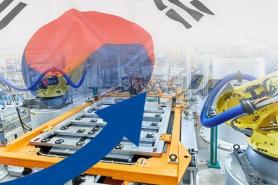
[Courtesy of Korea Electric Power Corporation]
SEOUL -- To expand renewable energy, it is essential to build large-capacity energy storage systems that store electricity generated by power plants. Korea Electric Power Corporation (KEPCO), a state electricity company, has developed a new large-capacity secondary battery that uses manganese oxides as a positive material to reduce costs.
The newly-developed battery is more stable and cheaper than large-capacity lithium-ion batteries that use intercalated lithium compound as a positive material. Lithium-ion batteries used in many electronic devices may become unstable, causing excessive heat or explosive combustions.
KEPCO said on Thursday that its new 20Ah-class secondary battery uses manganese dioxide as its positive electrode, making it ideal for storing power safely inside an energy storage system (ESS).
"KEPCO's new secondary battery, which can reduce the cost of constructing an ESS to half, will help the expansion of renewable energy sources in South Korea by vitalizing the use of ESS," a KEPCO official was quoted as saying.
Because the new battery cell uses manganese, the fifth abundant metal in the Earth's crust, it costs about half of lithium-ion batteries. KEPCO said that if all of the lithium-ion battery cells in South Korea's ESSs are replaced with the new manganese secondary batteries, a total of 25 billion won ($20 million) will be saved.
An ESS normally requires a minimum capacity of 20Ah for single-cell batteries. Battery cells are linked in packs to be fitted into the energy storage. A 20Ah battery cell has a power output of 2,400 watts, which is enough to operate a stove or a refrigerator for an hour.
KEPCO's new battery uses an inflammable electrolyte, so it is also more stable than lithium-ion batteries than can cause fire or explosive damage to other facilities. 23 ESSs went up in flames in South Korea between August 2017 and May 2019 and a state-private joint investigation team had concluded last year that 80 percent of fires were caused by malfunctioning batteries.
Copyright ⓒ Aju Press All rights reserved.




